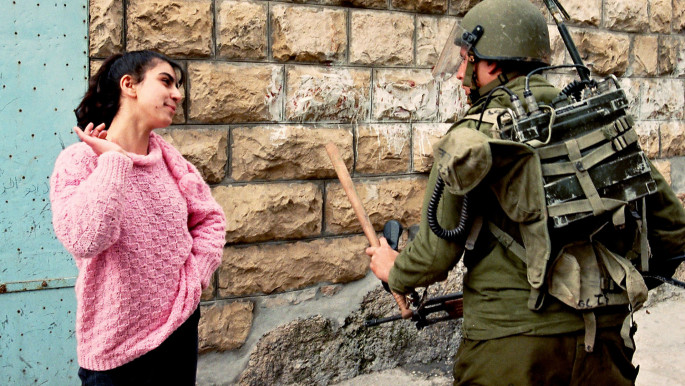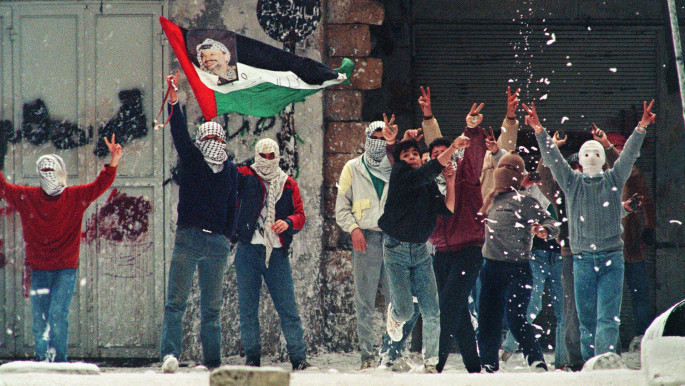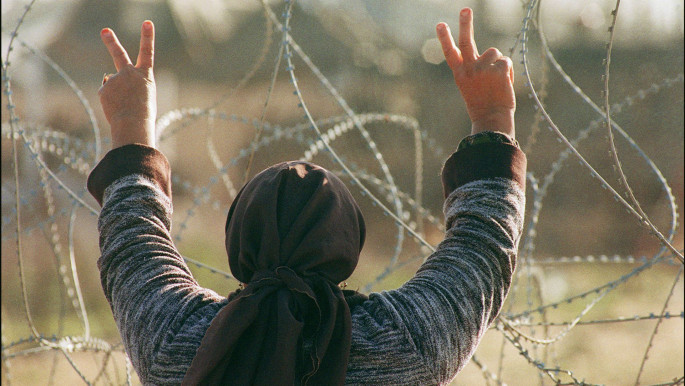From the streets to the committees, Palestine is united
Editor's note: This is the third and final instalment in al-Araby's series of testimonies marking the anniversary of the start of the First Palestinian Intifada.
Tayseer Arouri is a member of the Palestinian National Council and was a member of the Unified Leadership of the 1987 Intifada. Here, he shares his memories of Palestinian factions uniting into a national popular movement resisting the daily oppression meted out by the occupying Israeli army.
To understand how the First Intifada began, we need to look at developments in the occupied Palestinian territories the 1970s and 1980s.
These years saw a huge buildup of popular movements - unions, voluntary committees, youth groups and women's movements - standing up to the occupation. Smaller uprisings that took place during the time, in retrospect, looked like rehearsals for the intifada.
Great lessons were learned during this revolutionary period, and, by late 1987, the stage was set for a huge rebellion across the Palestinian territories. This helped make the intifada a rebellion that included all elements of Palestinian society and all ages.
The final spark that ignited the First Intifada was the murder of four Palestinian workers when an Israeli driver rammed his truck into their vehicle in Gaza. This inflamed the frustrations of Palestinians, already feeling betrayed by the Arab regimes.
This feeling of rejection culminated in the farcical 1987 Arab summit in Amman, where states appeared to back away from their commitments to the Palestinian cause. There were signals from the start that the Arab leaders intended to shun the Palestinian resistance, when King Hussein of Jordan snubbed Yasser Arafat by refusing to greet the PLO chairman at Amman airport.
Rise up
In the first couple of weeks of the intifada it became clear that this was not going to be like any other previous uprisings. A coordination committee had been set up with representatives of the four main Palestine Liberation Organisation [PLO] factions - the Communist Party, Fatah, the Popular Front [PFLP] and the Democratic Front [DFLP].
When the intifada started, the parties convened to evaluate to the situation on the ground with a clear consensus that the level of anger was unprecedented, and the rebellion had the potential to continue for a long time.
Gaza in particular bubbled with discontent, so when the funeral procession took place for the four workers, a solemn commemoration soon transformed into a mass demonstration with tens of thousands of angry protesters.
The coordination committee met frequently, and a decision was made to publish official communiques. Although at the beginning they were issued intermittently, they were soon issued on a regular basis, and people anticipated the contents every Monday morning.
One important piece of news was the decision to form a single leadership committee, named the Unified National Leadership of the Uprising [UNLU]. This was made up of one representative of each of the four factions to coordinate progress on the ground. I was the representative of the Communist Party.
We were also there to put forward the visions of our parties, to be included in the communiques. One of the four members would be assigned to create a draft statement based on the points the committee had agreed upon, including the political introduction that would proceed the instructions.
The member assigned for the task would prepare the draft and the UNLU members would take this back to their parties for comments. Once they returned this to the committee with any additional changes the four members of the UNLU would sit down to hammer out a final version.
One member was given the task of writing the draft and the final version on a rotating basis, making four copies for each of the UNLU member. They would then take it back to their party office for printing and distribution in their area of activity.
 |
|
| Israel occupied the West Bank in 1967. Two decades later, the intifada exploded [AFP] |
Message to the masses
The communique would contain general instructions for activists to take that week, with space to improvise depending on their particular situation. After the third, the UNLU adopted all of its political, strategic and tactical decisions unanimously, and no party was allowed to monopolise the decision-making process.
With each party possessing a wide network of support, they had to reflect the concerns and demands of the people they represented, from every city, refugee camp and village in the occupied territories.
For example, in the Communist Party, each area official was required to write a weekly report of events that had taken part in the locale. I would receive these reports and divide them into two parts - one part was used for the upcoming communique and the other part was sent out to the press.
We had begun to publish an English language report named FACTS through the Jerusalem Media and Communications Centre [JMCC], instead of the UNLU, and these statements would contain information about revolutionary activities that were otherwise blocked by newspaper editors.
There were three levels to our media work. First, there was information that we provided to the local press. Second, as more comprehensive reports, usually blocked by the Jerusalem press, which was sent out to al-Ittihad newspaper as it had a broader outlook. Finally, what information couldn't be published in the local media or al-Ittihad was released through FACTS.
This report was issued in English every week and distributed among journalists. We would also send these reports abroad, which proved difficult - as to reach the international press we would have to fax the report to London and Prague from a different location each time.
A few weeks into the intifada, Palestine became a centre point for the media with huge numbers of reporters coming in from across the world to cover the event. The JMCC had a small group of young English-speaking Palestinians who would accompany the foreign journalists to various locations helping to guide and translate.
The reason why the world's media was drawn to this event was partly due to the way the intifada was conducted.
Firstly was the level of organisation - the people abided by the instructions of the weekly communiques to an extent that baffled Israeli intelligence officers.
Secondly, there was a sense that the communiques reflected the wishes of the people and reality on the ground.
The statements also gave activists the freedom to improvise, which made it difficult for the Israelis to anticipate what would come next. Successful resistance actions soon became replicated elsewhere in the territories. This included placing the Palestinian flag in places that would be difficult for Israeli soldiers to reach, such as on electricity lines, to ensure they stood flying for a long time.
Participatory democracy
Everyone wanted to take part in the intifada. Not just slinging rocks at Israeli troops, but also through grassroots work in agriculture, education, and public security. I remember that lecturers at Birzeit University were eager to take part. I brought together two groups of lecturers, who didn't know each other, to meet at least once a week. In these gatherings we would discuss the intifada and daily events in the uprising.
Each lecturer would give his opinion on events that he or she was specialised in, and I would convey the ideas of the lecturers to the UNLU. After a few meetings, the lecturers saw that their ideas were beginning to appear in the weekly communiques, however, they all pretended not to not noticed.
| Leftist theorists considered the popular committees in the intifada one of the best examples of participatory democracy. |
Ehud Yaari and Zeev Schiff's book Intifada: The Palestinian Uprising – Israel's Third Front (1990) mentions that, based on intelligence reports there was a resistance committee at Birzeit University, however the two groups did not know about one another.
We only realised later that out work was having an impact on the global stage. After the demise of the socialist system, the left was unanimous in the belief that the socialist experiments in the Soviet Union and Europe had failed because they had not adopted an appropriate democratic model. In the 1990s, participatory democracy was identified as an appropriate model for socialism.
I was surprised that leftist theorists I met at a conference of leftist parties from across the world in Stockholm considered the establishment of popular committees during the intifada as being one of the best examples of participatory democracy.
As the intifada continued, the movement was able to manage a series of internal dynamics that allowed the intifada to continue, so long as tens of thousands of activists participated. The intifada only died because Israel, regressive Arab regimes, and even some PLO elements, worked against the uprising.
Fighting the expulsions
Israel began to round up large numbers of people who were active in the intifada during the last months of 1988. We realised that it was important to replace those arrested if the resistance to the occupation was to continue. The Israelis in turn expelled two groups of people they had arrested to other countries.
I was among a group of 17 others detained at al-Junaid prison in Nablus when we were told of the decision to expel us from Palestine, giving some of the most ridiculous reasons. Amram Mitzna, the commander of the central command, issued the expulsion order of those responsible for heading and establishing popular committees. The decision was issued a week before a military directive outlawed the committees.
We decided to fight the expulsion order and as a response formed the Expulsion Resistance Front.
We informed our lawyers about our decision to fight the order, which we hoped would exhaust the Israelis by prolonging the legal process against us.
The first course we took was to go through the military appeals committee, which took months. Some members of the group did not wish to proceed further for various reasons and allowed themselves to be expelled. The five of us who remained went on to battle in the high court for eight months, during which a solidarity movement had developed, and due to local and international pressure, additional expulsion decisions were stopped.
We also discovered that detainees who did not have a passport were expelled to the south of Lebanon, which was occupied by Israeli troops.
As my Jordanian passport had been confiscated, my family and friends tried to have me expelled to a country other than Lebanon or Jordan. The Israelis did not agree to this until the final high court decision about the matter was reached. They said that I could move to another country provided that they would agree to host me, believing that I would not find a host nation.
The Red Cross and the JMCC contacted several foreign consulates and France agreed to host me. Then Greece, Cyprus and Italy followed. The speed of this surprised the Israelis. While four of my colleagues were banished to Lebanon, I was expelled to Paris.
A letter was addressed to Yitzhak Rabin, who was minister of defence at the time, signed by 1,400 physics and mathematics professors. It stated that the expulsion of Tayseer Arouri was illegal, and if there were charges against him he should be tried and not expelled.
In a meeting with some Knesset members, Rabin reportedly responded that expelling Arouri was going to be a problem, but not expelling him was an even bigger problem - therefore they would not change their decision.
 |
|
| Protests and riots swept through Palestine in 1987 [AFP] |
UNLU and PLO
No one person started the intifada, however, as participation grew and the resistance spread, the PLO's leadership attempted to contain the rebellion.
It began when a Fatah official came to the UNLU with a message from Tunis, the headquarters of the PLO at the time.
The leadership requested that we send the draft communique to Tunisia and then the organisation would publish the final version. What happened next showed a degree of cooperation and coordination between the different factions in Palestine who were taking part in the intifada.
Before the Fatah official finished his sentence he said, "I know you will not agree to this, we also do not agree to this, but let us agree to discuss the subject in the [UNLU] meeting, and we will not argue with any who object."
That is what happened; the request was discussed and rejected, with the argument made that the communiques dealt with local issues and so could not be addressed by those in Tunisia. The meeting then moved on to the next issue up for discussion.
This close-knit relationship among the UNLU members continued until 1990, when the mechanisms of the committee's work changed, placing it under the direct supervision of the media committee. During the same period the factional coordination committee was disbanded, which naturally led to the dissolution of the UNLU.
In 1988, US Secretary of State George Shultz was due to visit the West Bank. At the time, secret meetings were taking place between the PLO and the US, with Shultz due to meet four leading Palestinian figures with close links to Jordan and Fatah.
The UNLU decided the meeting was a bad idea, as they believed that neither Jordan nor Fatah fully represented the Palestinian people or the intifada. There was also the understanding that these talks should not take place without the participation of the leadership inside Palestine.
The Fatah representative to the UNLU said that, as these people were connected to the party, he would inform them of the UNLU's decision - and the men were informed that they would not be allowed to meet Schultz. This decision marked the beginning of the struggle between the UNLU and the PLO leadership in Tunisia.
Opinions expressed in this article remain those of the author and do not necessarily reflect the opinions of al-Araby al-Jadeed, its editorial board or staff.




